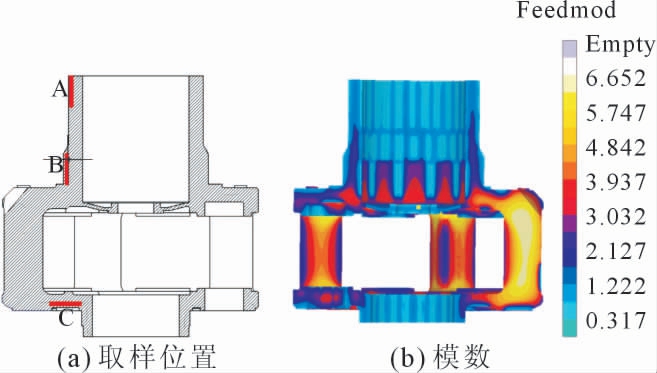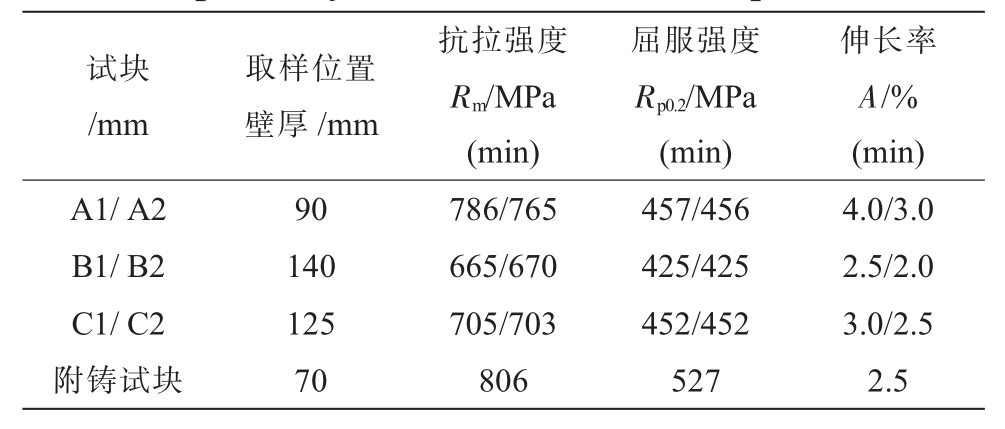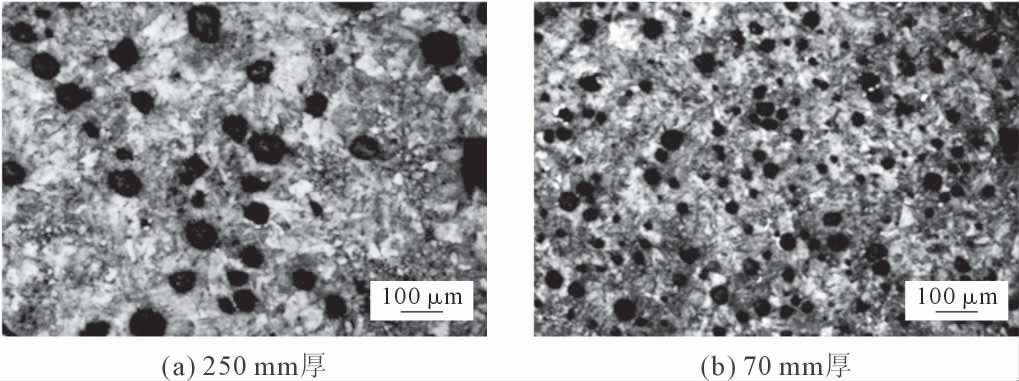球墨铸铁因为优良的铸造工艺性和力学性能在工业中广泛应用[1-3],在风电行业,球墨铸铁常用于铸造轮毂,底座和齿轮箱结构件。行星架作为齿轮箱的重要结构件,在齿轮传动过程中,承受的载荷较大,工况复杂,是齿轮箱中技术要求最高的铸件[4-6]。考虑行星架对材料强度要求较高,通常选用珠光体含量较高的QT700-2A材料以满足所需力学性能。
1 实验方背景和实验目的
不同壁厚铸件冷却速度不同,铸件的组织和性能也不一样[7-10]。 GB/T 1348-2019球墨铸铁件标准对不同壁厚的性能要求见表1,可以看出,铸件壁厚越大,附铸试块强度和伸长率要求越低。
表1 QT700-2A 附铸试块力学性能要求
Tab.1 The mechanical properties requirements of attached casting test blocks of Qt700-2A

?
随着近年风电主机功率不断提升, 风电铸件的重量和壁厚也在不断刷新。 大兆瓦齿轮箱低速级行星架最大壁厚甚至超过200 mm。 表2是某型号齿轮箱低速级行星架的铸件本体解剖数据, 最大内切圆直径280 mm,取样位置见图1。 可以看出,对于同一铸件, 不厚壁厚区域的铸件本体力学性能存在明显差异, 厚壁区域力学性能远低于70 mm厚标准附铸试块的力学性能。此时,70 mm厚的附铸试块已无法准确反映本体厚壁区域的力学性能。 考虑行星架上很难找到合适的套料位置,而整体解剖成本又太高,通过检测和本体性能更接近的大试块力学性能来评估本体力学性能成为比较经济实用的一个方法。

图1 行星架的模数和取样位置
Fig.1 Modulus of the planetary carrier and sampling locations
表2 行星架本体和附铸试块的力学性能
Tab.2 Mechanical properties of samples cut from planetary carrier and cast-on samples

?
2 实验方案
针对壁厚对冷却速度的影响,设计不同壁厚的附铸试块,对比不同试块同一取样位置,以及同一试块不同取样位置在力学性能差异,抗拉试棒取样位置见图2,试块尺寸见表3,每种试块各浇注3个。

图2 抗拉试棒从附铸试块的取样位置
Fig.2 Tensile specimens sampling locations from cast-on block
表3 附铸试块尺寸
Tab.3 Dimensions of cast-on test blocks

?
采用中频感应电炉熔炼,炉料由40%废钢,40%生铁和20%的回炉料构成, 主要化学成分控制范围见表4,采用一次包底孕育二次随流孕育的工艺,铸件和附铸试块采用正火+回火热处理工艺。
表4 QT700-2A化学成分 w/%
Tab.4 Chemical composition of QT700-2A
?
3 实验结果及讨论
实验数据见图3,可以看出:随着试块增大,抗拉强度和屈服强度逐渐降低, 但抗拉强度降低趋势更显著。对于同一试块,无论是抗拉强度还是屈服强度,与取样位置并未发现明显的关联性。

图3 不同壁厚附铸试块的强度
Fig.3 Serength of cast-on blocks with different thickness
铸件的模数可以很好地反应铸件在凝固和冷却过程中的散热条件:
M=V/A(单位:cm)
式中,V是体积;A是散热表面积。考虑到铸件实际结构比较复杂, 通过Magmasoft计算获得凝固模数,结果见图4。

图4 不同壁厚附铸试块的凝固模数分布(单位cm)Fig.4 Modulus of cast-on sample with different thickness
从图5金相图片看出:250 mm厚附铸试块和70 mm厚附铸试块虽然珠光体含量没有显著差异,但70 mm厚试块珠光体组织更细,石墨球直径也更小。珠光体的形成速度与冷却速度呈强正相关关系,而珠光体片间距和石墨球直径与冷却速度呈强负相关关系[11-13],因此,更快的散热速度能得到更细的珠光体组织和更小的石墨球, 这是不同壁厚试块性能差异的一个主要原因[14-15]。

图5 不同壁厚附铸试块的微观组织
Fig.5 Microstructures of cast-on blocks with different thickness
图6 是试块和本体取样区域心部模数与力学性能的散点图,可以看出:强度随模数增加而降低,当试块最大模数和本体取样区域最大模数接近时,力学性能数据分布也非常接近。

图6 模数与强度的相关性
Fig.6 Correlation between modulus and strength
4 结论
(1)薄壁试块比厚壁试块强度高,其中抗拉强度随壁厚增加下降趋势强于屈服强度。
(2)对于壁厚较大的铸件,70 mm 厚附铸试块已无法准确反映厚壁区域力学性能,在没有合适套料位置的情况下, 浇注模数与本体接近的大试块加工拉伸试样, 能够更加准确地反映本体力学性能。
[1] 张伯明. 铸造手册1: 铸铁[M]. 第3版. 北京:机械工业出版社,2011.
[2] 龚文邦,白新社,刘金城. 球墨铸铁的发展[J]. 现代铸铁,2019,(4):31-36.
[3] 杨佳荣. 球墨铸铁研究及应用展望[J]. 现代铸铁,1999(2):5-8.
[4] 程继余,薛惠芳. 双馈式风电机组齿轮箱分析[J]. 机械制造与自动化,2018,1(14):50-52.
[5] 刘桂然. 关于风电齿轮箱的设计技术分析[J]. 科技经济市场,2020(14):9-11.
[6] 孙黎,石鹏飞,代海涛,等. 风电齿轮箱低速级行星架极限强度分析[J].机械制造,2017(8):49-52.
[7] HAJI M, HASSE F. Effect of the cooling rate on the graphite nodule count and size distribution in nodular cast iron[J].Materials Science Forum,2018,925:45-53.
[8] TANAKA Y, YANG Z, MIYAMOTO K. Evaluation of fatigue limit of spheroidal graphite cast iron[J].Materials Transa ctions,1995,36(6):749-756.
[9] 刘宗昌.热处理工程师必备理论基础[M]. 第1版. 北京: 机械工业出版社,2013.
[10] 吴广河,沈景祥,庄蕾. 金属材料与热处理[M]. 北京: 北京理工大学出版社,2018.
[11] WHITING M J. A reappraisal of kinetic data for the growth of pearlite in high purity Fe-C eutectoid alloys[J]. Scripta Materialia,2000,43:969-975.
[12] 刘峰,杨屹,付骏. 球墨铸铁中珠光体开始转变动力学数学模型[J].热加工工艺,2007,36(17):12-15.
[13] 张锁梅,黄卫华,邢长虎,等. 不同冷却速度下球墨铸铁的基体组织[J].现代铸铁,2000(4):29-32.
[14] 徐知行, 朱先勇. 铸态珠光体球墨铸铁组织和力学性能数学模型[J].新技术新工艺,2008(8):77-79.
[15] 刘金海,李国禄,郝晓燕. 球墨铸铁微观组织与拉伸行为的相关性[J].铸造技术,2009,30(3):329-331.